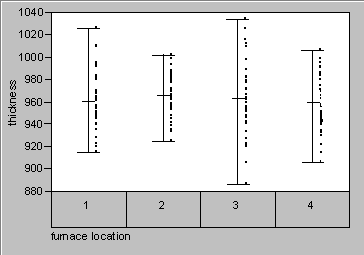3.
Production
Process Characterization
3.4.
Data Analysis for PPC
3.4.4.
|
Analyzing Variance Structure
|
|
|
Studying variation is important in PPC
|
One of the most common activities in process characterization work
is to study the variation associated with the process and to try to
determine the important sources of that variation. This is called
analysis of variance. Refer to the section of this chapter on
ANOVA models for a discussion of
the theory behind this kind of analysis.
|
| The key is to know the structure |
The key to performing an analysis of variance is identifying
the structure represented by the data. In the ANOVA models
section we discussed one-way
layouts and two-way layouts where the factors are either
crossed or
nested. Review these
sections if you want to learn more about ANOVA structural layouts.
|
|
|
To perform the analysis, we just identify the structure, enter the
data for each of the factors and levels into a statistical analysis
program and then interpret the ANOVA table and other output. This
is all illustrated in the example below.
|
|
Example: furnace oxide thickness with a 1-way layout
|
The example is a furnace operation in semiconductor manufacture where
we are growing an oxide layer on a wafer. Each lot of wafers is
placed on quartz containers (boats) and then placed in a long
tube-furnace. They are then raised to a certain temperature and held
for a period of time in a gas flow. We want to understand the
important factors in this operation. The furnace is broken down into
four sections (zones) and two wafers from each lot in each zone are
measured for the thickness of the oxide layer.
|
|
Look at effect of zone location on oxide thickness
|
The first thing to look at is the effect of zone location
on the oxide thickness. This is a classic one-way layout. The factor
is furnace zone and we have four levels. A plot of the data and an ANOVA
table are given below.
|
|
The zone effect is masked by the lot-to-lot variation
|

|
|
ANOVA table
|
Analysis of Variance
| Source |
DF
|
SS
|
Mean Square
|
F Ratio
|
Prob > F
|
| Zone |
3
|
912.6905
|
304.23
|
0.467612
|
0.70527
|
| Within |
164
|
106699.1
|
650.604
|
|
|
|
|
Let's account for lot with a nested layout
|
From the graph there does not appear to be much of a zone effect; in
fact, the ANOVA table indicates that it is not significant. The
problem is that variation due to lots is so large that it is masking the
zone effect. We can fix this by adding a factor for lot. By treating
this as a nested two-way layout, we obtain the ANOVA table below.
|
|
Now both lot and zone are revealed as important
|
Analysis of Variance
| Source |
DF
|
SS
|
Mean Square
|
F Ratio
|
Prob > F
|
| Lot |
20
|
61442.29
|
3072.11
|
5.37404
|
1.39e-7
|
| Zone[lot] |
63
|
36014.5
|
571.659
|
4.72864
|
3.9e-11
|
| Within |
84
|
10155
|
120.893
|
|
|
|
|
Conclusions
|
Since the "Prob > F" is less than 0.05, for both lot and
zone, we know that these factors are statistically significant
at the 0.05 significance level.
|


